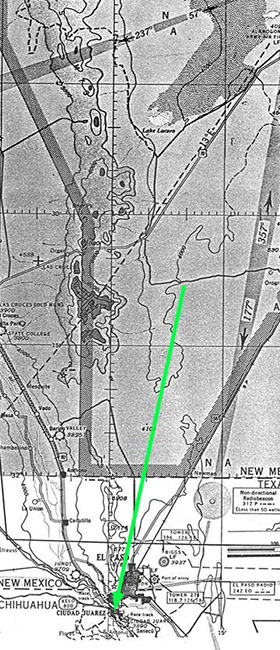Bliss Zero Runaway
and the Radical Cruise Missile Experiments of Project Hermes II
Precursor of the Roswell Incident: May 29, 1947
Introduction: The US Army was eager to exploit the advanced missile technology developed by the German rocket designers during World War II. It shipped many V-2s from German assembly and test facilities to remote White Sands Proving Ground in New Mexico for research and development purposes. Army Ordnance contracted with the General Electric company to develop US versions of the German missiles and their engine and guidance technology. Many members of the original German Peenemunde "Rocket Team" that had designed the V-2 were brought to the US along with the missiles and contributed to the US development work. They also conducted unique research in parallel with US advanced missile developments. One such project was derived from WWII concepts for multistage versions of the V-2 with wings and airbreathing engines for extended range. A spring 1947 test launch of this missile, which "ran away" and impacted in Mexico, just over a month before the Roswell incident, may have sensitized military officials to the need to exercise more control over media releases related to secret projects, and evidently heightened concern over other reported "mystery missile" crashes in the Southwest later in 1947.
This article consists of two parts:
Part 1 describes the Hermes II cruise missile and its May 1947 crash in Mexico
Part 2 examines the October 1947 "mystery missile" crash reports
V-2-Derived Cruise Missiles
During WWII, Peenemunde's rocket experts under Dr Wernher von Braun examined ways to extend the range of the A4 (V-2) ballistic missile. The typical operatonal V-2 could deliver a metric ton high-explosive warhead to a target some 175-200 miles from its launch site. Addition of wings to the rocket, along with improved engines and other upgrades, promised to double this performance. A huge booster stage could push this range to nearly 3000 miles. Another concept studied during the war, but not implemented, was addition of a ramjet engine -- a type of lightweight jet propulsion system -- to provide high-speed cruise power after rocket engine burnout.
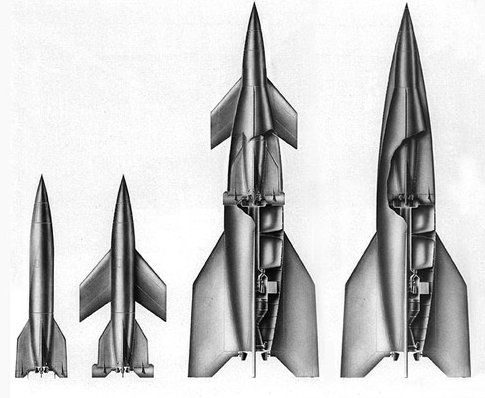 |
Chart of V-2 variants includes concepts for two-stage missiles with ranges between 1500 and 3000 miles. These WWII concepts were highly influential on postwar US thinking about long-range missiles, which placed emphasis on high-speed winged vehicles rather than intercontinental-range ballistic-trajectory designs. This well-known illustration has been altered to show the two-stage A10/A4b with swept wings, third from left, which was evidently the basis for the Hermes II vehicle designed by the von Braun team of German rocket engineers in Texas in 1946 |
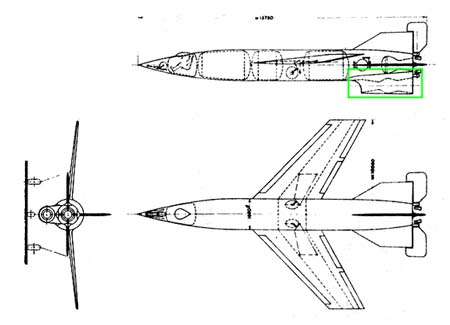 |
Wartime concept for manned, winged V-2 known as A9. Rocket-boosted to supersonic speed, the vehicle would use an air-breathing ramjet (highlighted) for long-range cruise propulsion |
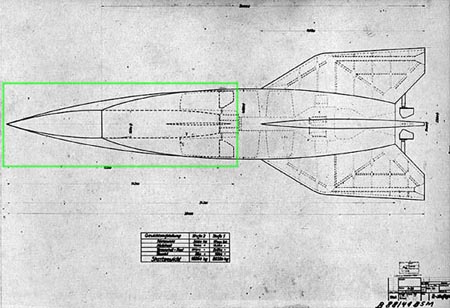 |
Another version of the A9 had chine-like delta wings of extreme sweep and was intended as the second stage of the A9/10 missile with transatlantic range. Both of these concepts were in the genetic lineage of the New Mexico V-2-derived cruise missile projects See: A9 |
The US Army had initiated the Hermes project to develop guided missiles in the fall of 1944, with General Electric as its prime contractor. After the surrender of Nazi Germany, Project Hermes adapted recovered German V-2 components for testing at White Sands, NM beginning in 1946, and also moved ahead with research, development and testing of GE's own designs for ballistic and surface-to-air missiles, all of which became heavily influenced by the wartime German work.
At the same time , North American Aircraft launched a similar ambitious missile program based on the V-2 under contract to the Army Air Force. For various institutional reasons, the Air Force in the post-WWII period was not enthused with ballistic missiles and planned to develop a fleet of winged "unmanned bombers" that covered the spectrum of speed and range. In the short term, the Air Force studied subsonic, jet-powered winged missiles with ranges of some 500 miles, and planned long-range jet-powered missiles, such as Northrop's "Snark," that would be capable of carrying a nuclear payload over intercontinental ranges. Likewise, it initiated design studies for supersonic intercontinental cruise missiles under the Northrop "Boojum" and North American "Navaho" designations, among others.
 |
1948 North American chart shows various configurations of winged supersonic missiles under study. The "Mod German A-4b" was the Peenemunde A9, and the "Canard Config" was an aerodynamically rearranged and improved version of this. The XSSM-A-2 (North American model NA-704) was a V-2 modified to canard configuration with the addition of two very large ramjet engines for cruise flight after rocket burnout. The chart indicates that three such airframes had been built at the time, but none had been flown. Ultimately, a version of the futuristic "5000 Mile Ramjet Missile" was developed over the course of a decade as the Navaho cruise missile |
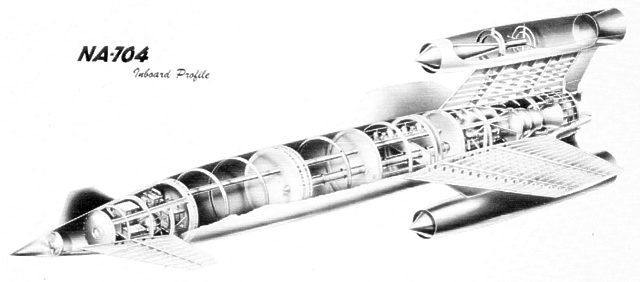 |
The NA-704/XSSM-A-2 proto-Navaho (Air Force designation MX-770) was a very impressive vehicle that represented the US rocket design state of the art in 1947-8. It was a lengthened V-2 with extra tankage for ramjet fuel and numerous structural improvements, giving the missile five times the range of a standard V-2. Guidance technology equal to such an advanced airframe was years in the future |
In 1946 General Electric began conceptual work on a ramjet-powered missile with similar performance, called Hermes B. It was not as aerodynamically interesting as the North American concepts, but it was designed to burn an exotic high-energy fuel known as boron hydride, a highly toxic liquid which would ignite on contact with air. Although the Hermes B was only 40 feet long, it was designed to carry a 5,000 pound warhead over a 1,500 mile range at 2,600 mph.
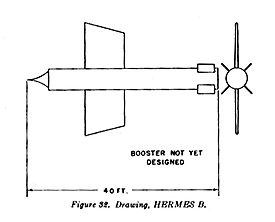 |
Hermes B ramjet cruise missile conceptual drawing from January 1948 Army Ordnance report |
Von Braun's Peenemunde team was brought to Fort Bliss, Texas and was allowed to consult with the Army rocket development experts and other missile design groups, but apparently was kept at arm's length from the details of actual projects in the early years, much the same way that the Soviets handled their own German rocket experts. Von Braun was allowed to daydream about futuristic orbital rockets and space stations, and to experiment with ramjet-powered V-2-derived cruise missiles in parallel with the Army and Air Force winged missile programs.
See: 1946 White Sands Concepts for Orbital Spacecraft
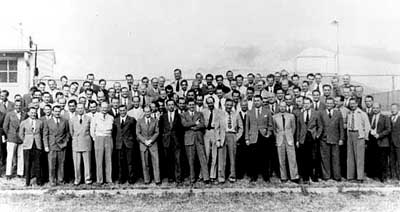 |
The Peenemunde Rocket Team at Fort Bliss, 1946-7. Wernher von Braun is center right, with hand in pocket, dark slacks. Ernst Steinhoff, head of the Guidance and Control group, is to his left US Army Redstone Arsenal |
A special Hermes supplemental contract (amounting to some $4 million, according to one source) was let to GE in April 1946 by the Ordnance Research and Development Division Suboffice (Rocket) at Fort Bliss, where the Germans were housed, for fabrication and testing of components of Hermes II, yet another winged cruise missile program. (Other designations associated with this program include "Hermes B-1" and "RTV-A-6 Research Test Vehicle"). Like Hermes B, Hermes II was a winged, long-range supersonic surface-to-surface cruise missile using ramjet propulsion.
Hermes II differed from the other project in that its engines were unique propulsive ducts incorporated directly into short, rectangular wings. Project documents indicate that the original intent of the Peenemunde group was to conduct a ten-missile launch program to test and validate the aerodynamic, propulsion and guidance systems of a production missile of similar design. "The [Hermes II] missile may be considered a prototype of larger models to carry heavier payloads to greater distances," according to a program history. The launch vehicles for the Hermes II would be German-built V-2s with significant modifications. The project was classified "Secret" and its launches were not listed in the standard GE Hermes V-2 tables.
The Hermes II cruise stage, known as the "Ram," was built in the external shape of the V-2's warhead/guidance section, probably to minimize aerodynamic unknowns, but had an extended tail cone that nested in a recess built into the upper dome of the booster's alcohol tank. The Ram's wings spanned 15.25 feet and incorporated rectangular-section ramjet engines, apparently of original GE design and nicknamed the "Organ," which were capable of supporting combustion at speeds of Mach 3 or more. The ramjets had a "sharkmouth" inlet profile, and in the initial flight test phases incorporated mockup ducts of different lengths for pressure profile testing at high speeds. For powered flight testing, "hydrocarbon fuel plus additive" was planned, giving a predicted thrust of 2,948 pounds, with sufficient fuel for 400 seconds of burn time.
The first five Hermes II missiles, numbered 0 through 4, were intended to feature aerodynamic replicas of the ramjets and other aerodynamic surfaces and did not have separating second stages, while missiles 5-9 were to have "live," free-flying Ram stages with guidance. Ground testing of the ramjet injectors, guidance platform and other components was to progress in parallel with flight tests of simulated engine hardware prior to full-up, live free flights. During these tests, the V-2 would boost the Ram stage to high speed at about 50,000 feet, where pressurized pistons would eject it. When the Ram had coasted to 66,000 ft, the ramjets would ignite and the stage would begin its winged flight profile. The Ram vehicle was 17.85 feet long, 50.87 inches in diameter, and weighed 5,651 pounds loaded, of which 1,398 pounds was fuel. The original specification envisioned a 500 pound payload and 500 miles range. The Ram's control surfaces consisted of small canard elevators near the nose, spanning 59.35 inches, and a rudder with a height of 58.87 inches. Maximum speed anticipated as of the early stages of the program was 3,180 fps/2,168 mph; at this speed the Ram would fly some 240 miles during its powered phase.
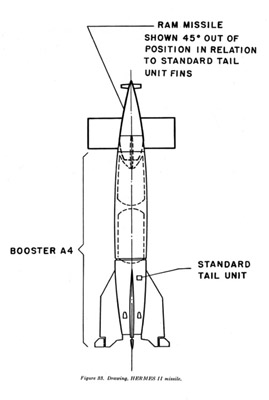 |
Early Army Ordnance elevation drawing of the Hermes II two-stage rocket-boosted ramjet cruise missile |
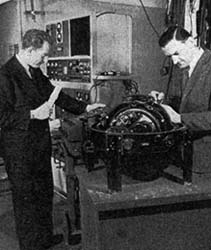 |
Special inertial guidance gyroscope platform developed by the Fort Bliss Germans to control the sophisticated cruise missile. It was an ancestor of the unit that guided the Saturn V moon rocket of the 1960s. At the time, large two-stage rockets had yet to be tested, but the Germans were designing an extremely ambitious guidance system for the Hermes II missile. The unit, which was installed in the missile's second stage, would have to control the V-2 booster stage during launch, then maintain control of the cruise stage as it separated from the rocket, transitioned to horizontal wingborne flight and ignited its engines, then guide it for a period of several minutes - compensating for wind gusts, thrust asymmetries, and even the rotation of the earth - before cutting off the engines and diving the missile onto its target. The Hermes II guidance platform must have been one of the earliest units designed to be installed in the second stage of a two-stage guided liquid-fuel rocket - if not the first ever |
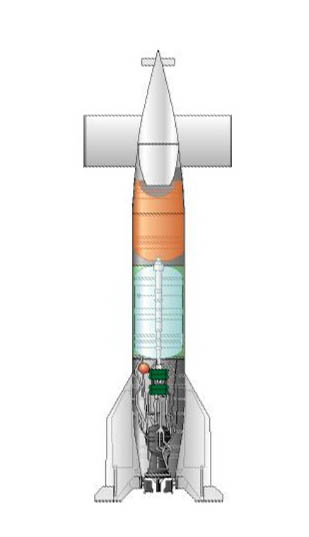 |
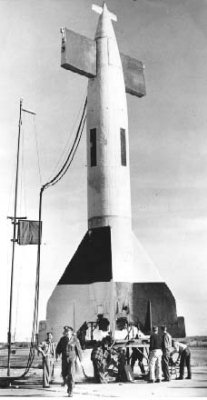 |
Hermes II RTV-A-6 test vehicles on White Sands launch pad. Large wedge-shaped protrusions near nose are the GE "Organ" experimental ramjets integral with cruise stage wings. V-2 fins and control surfaces have been greatly enlarged Note that the Ram wing appears to be oriented on the pad in such a way that the missile would fly a "zero-lift" trajectory at this stage of the flight test program (ie, the wings are oriented north-south, in the rocket's pitch plane). "Organ" ducts were instrumented to provide telemetry on duct pressure profile for comparison with estimated data |
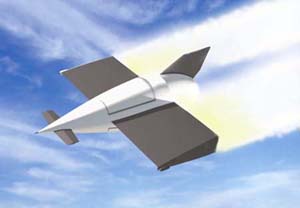 |
Conceptual rendering of the RTV-A-6 Ram supersonic cruise missile test vehicle in ramjet-powered wingborne flight after separation from its booster j carpenter 3.2002 |
 |
The missile's "lenticular ramjet" engines were similar to this "rectangular ramjet" shown in captive flight test on a NACA aircraft in 1947. Engines built directly into wings were a trendy technology in the postwar period NASA |
Runaway
The first Hermes II ramjet test missile, dubbed "Bliss Zero," was readied for flight in late May 1947. The launch would be under control of a Peenemunde/Army team with Ernst Steinhoff as launch director.
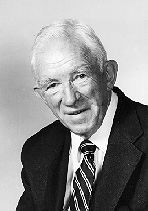 |
Ernst Steinhoff late in life. Steinhoff's brother Friedrich was a submarine captain and helped the Peenemunde rocket team conduct launches of small 30 cm antiaircraft rockets from the submerged U-511 in 1942 as a demonstration of the possibility of submarine-launched versions of the V-2. On May 16, 1945 Friedrich Steinhoff sailed his last command, the U-873, into Portsmouth Harbor, New Hampshire, surrendering to US officials. He committed suicide in a Boston prison three days later US Army Redstone Arsenal |
The vehicle was equipped with instrumented replicas of the ramjet ducts and was programmed to fly nearly vertically, with a pitch angle of only 7 degrees north, to keep it well within the White Sands range. But a guidance problem was to insure that this test of the classified cruise missile components would become perhaps the most famous V-2 launched in the US.
A first launch attempt on the afternoon of May 29 was cancelled when the V-2's engine failed to achieve full thrust. Repairs were made and Missile 0 was finally fired at 7:30 PM and at first seemed to be performing nominally. But the pitch program failed to begin at T plus 4 seconds and the rocket continued to climb vertically. Steinhoff and his range safety observers hesitated to send the cutoff command. Just before burnout at T plus 46 seconds, the missile pitched gently south. Speeding upward at Mach 3 or more, Bliss Zero reached a peak altitude of 49.3 miles, hurtled over El Paso, crossed the Rio Grande and impacted 47 miles from its launch site on a rocky hill about three miles south of the town of Juarez, blasting a crater 25 feet deep and 30 feet in diameter. "The rocket was not judged to be in error great enough to take it the distance it finally acquired," the program history notes laconically.
"Telemeter records of the 'Organ' functioning were only partially satisfactory," according to the flight log. "The 'Organ' chamber between fins I and II, having a long intake nozzle, shows a variation of the pressure, the highest pressure being reached when the outlet nozzle has its smallest cross-section. No 'Organ' chamber pressures were obtained from those chambers having short intake nozzles. This was due to a failure in the respective telemetering channels. No reason for this failure is yet apparent."
Ironically, since the missile passed so close to Fort Bliss, many Army personnel who were familiar with the project were watching the flight (which produced a heavy contrail that was illuminated by the evening sun) and were eyewitnesses to its terminal dive and impact. One of these was Major General John L. Homer, commander of the Army base. Homer started a minor flap when he reported that seconds prior to the rocket's impact he had seen a smaller explosion several miles away on the west side of Mount Franklin, on the US side of the border just northwest of El Paso. Eight soldiers from the base were detailed to search the site in case "a portion of the rocket had sheared off and dropped on Mount Franklin." If the simulated ramjet components or other parts of the experimental payload did separate from the rocket, the project records make no comment. Naturally it was impossible to conceal the fact that the missile was a V-2 from White Sands, but the exact nature of the advanced systems under test was not revealed for many years.
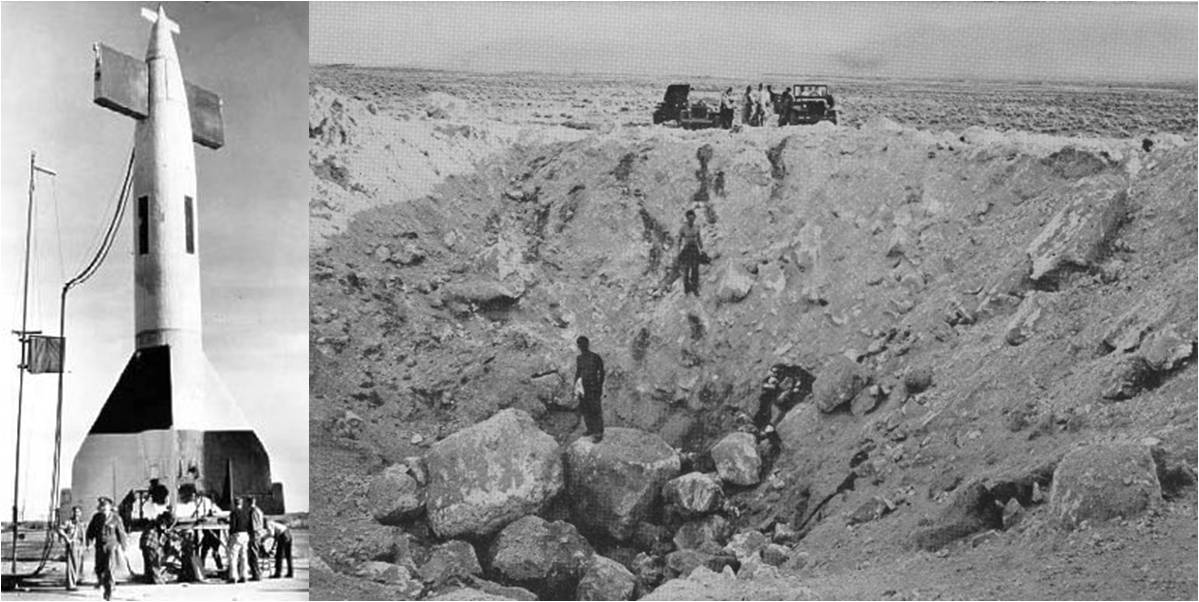
Judging from news accounts, little identifiable debris survived at the main impact site. Colonel Harold Turner, the commander of the White Sands launch facility, told reporters that a "failed gyroscope" was the cause of the runaway, but it is not clear whether the unique new inertial system actually was "miswired," as many sources state, or whether some other problem caused the last-minute pitch to the south. One former White Sands missile technician concluded that the pitch program had completely failed and that high-altitude winds simply caused the rocket to weathervane to the south. In any case, the V-2 program stood down for some time after the embarrassing incident, and much more stringent range safety procedures were implemented for later White Sands launches.
According to a tentative White Sands launch schedule issued in late June 1947, well after the accident, Hermes II Missiles 1 and 2 were still slated to be flown on July 31 and October 2, respectively. But apparently this never happened, and the last three missiles in the series were launched on January 3 and October 6, 1949, and November 9, 1950. Available records do not state whether any of these flights were equipped with a live Ram stage or ramjets. Other V-2s carried payloads related to the Hermes II program, including flights 24 (April 17, 1947), 44 (November 18, 1948) and 46 (May 5, 1949), which had warhead sections replaced with instrumented full-scale replicas of cylindrical GE A-4 ramjet ducts.
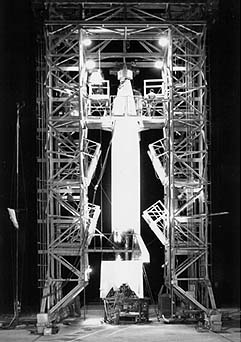 |
 |
V-2 44, far left, and closeup of its A-4 ramjet payload, left
|
The ramjet engine development program continued after the Peenemunde group was moved to Redstone Arsenal in Huntsville, Alabama (in fact, one Army Ordnance history suggests that lack of room for the active Hermes II program at Fort Bliss was one of the reasons the Peenemunde group was moved to the larger Huntsville facility) and by 1952 the Hermes II missile's performance targets had increased to an impressive degree, with speeds of Mach 4.5 over a range of 1,500 miles at altitudes of 80,000 feet being discussed. The program was cancelled in September 1953 as emphasis shifted to the Redstone ballistic missile, which quickly overshadowed the first US project of the former Peenemunde rocket team.
